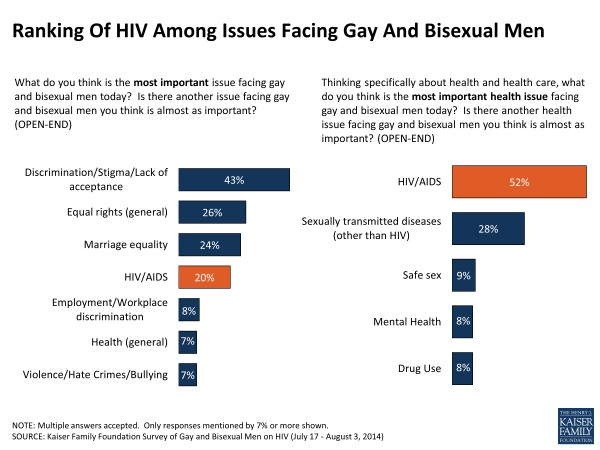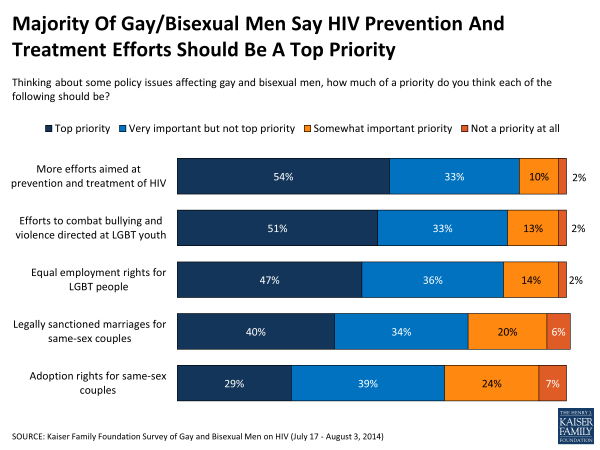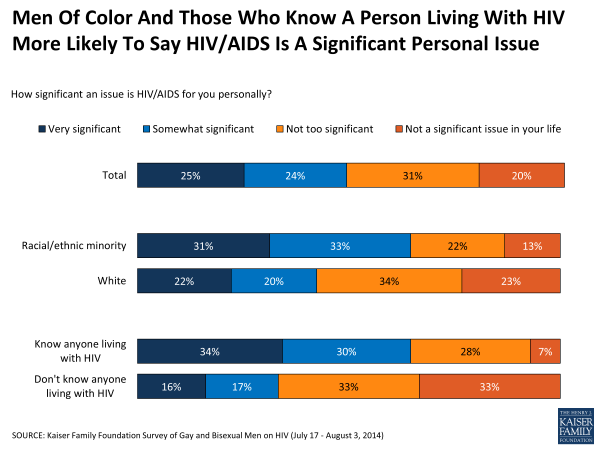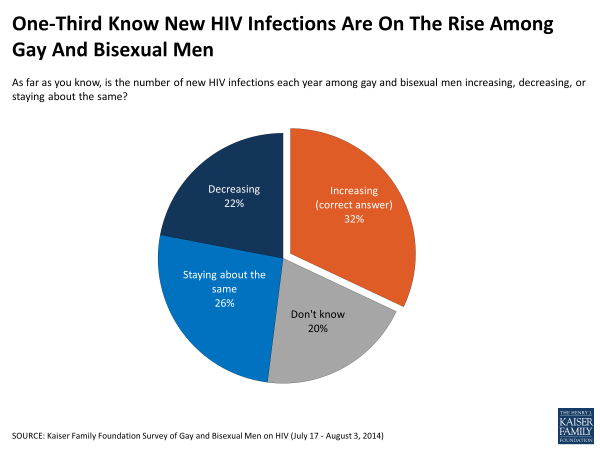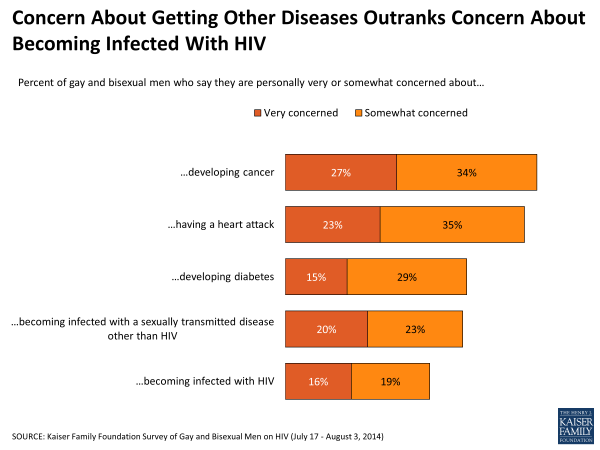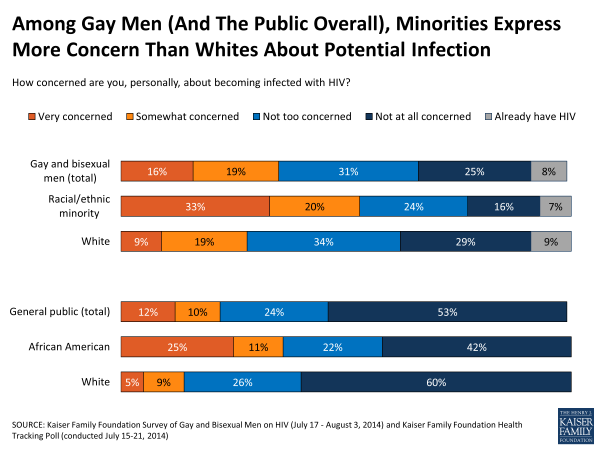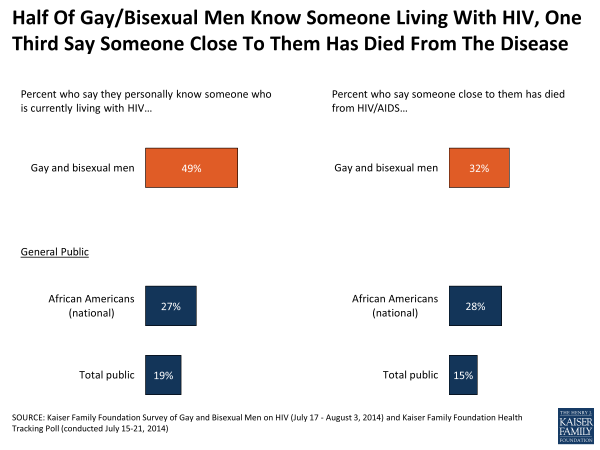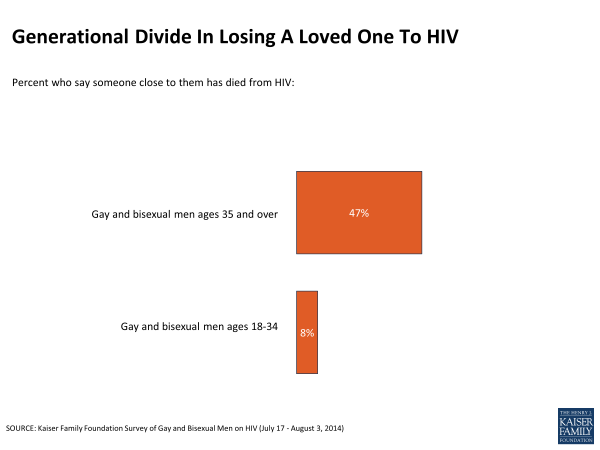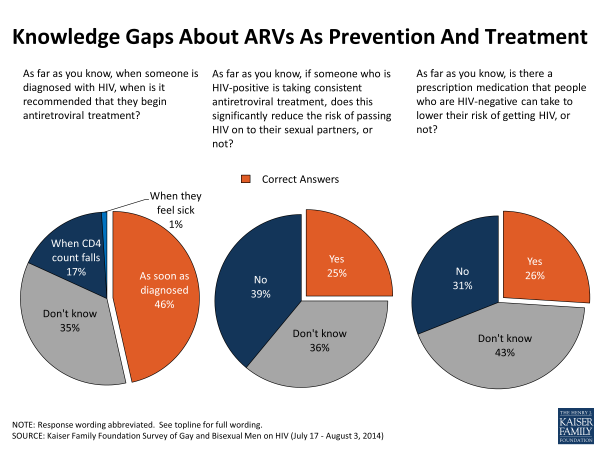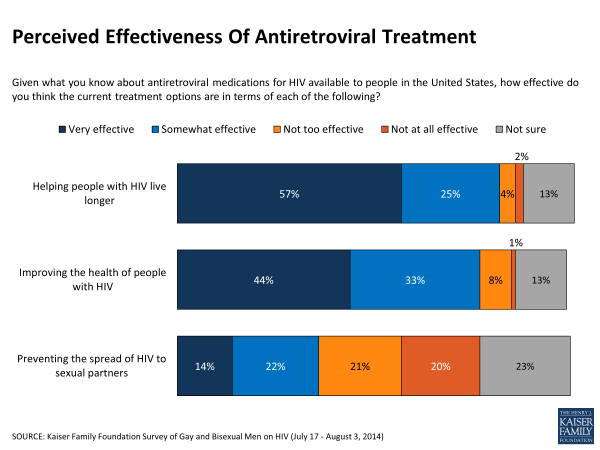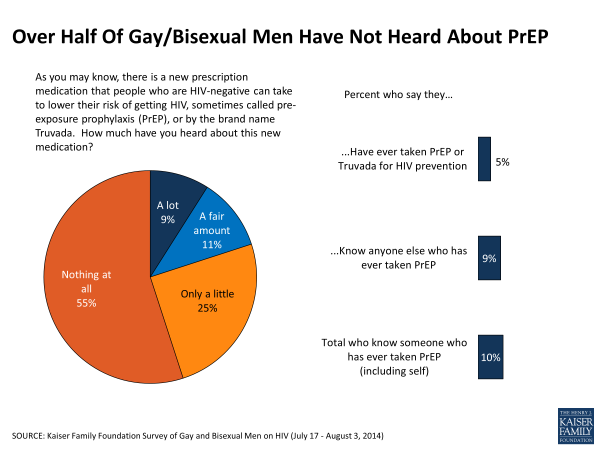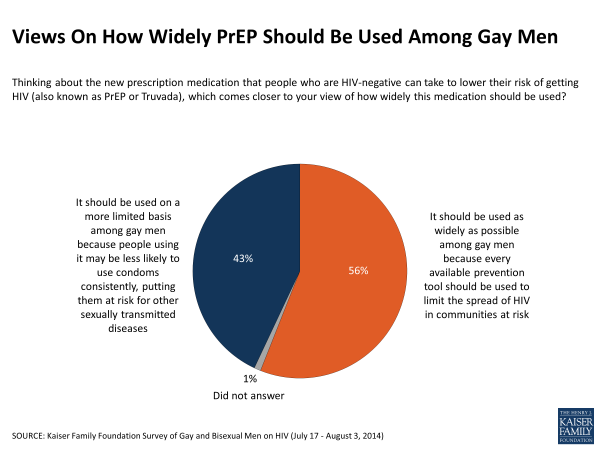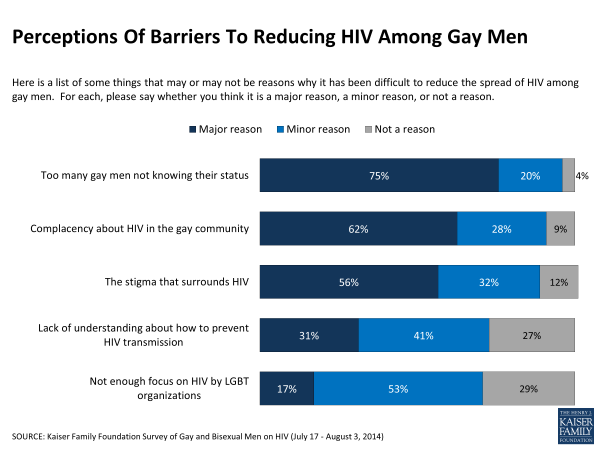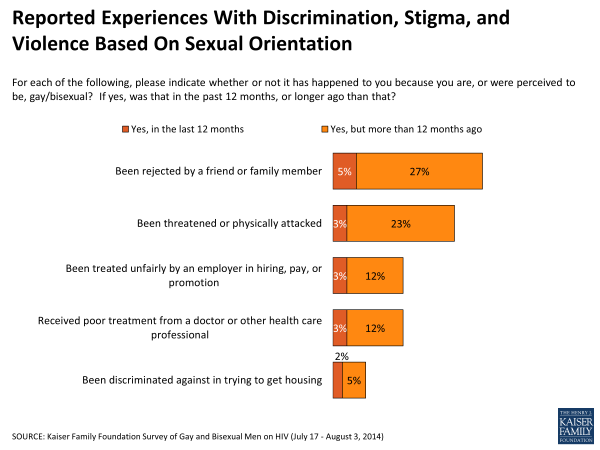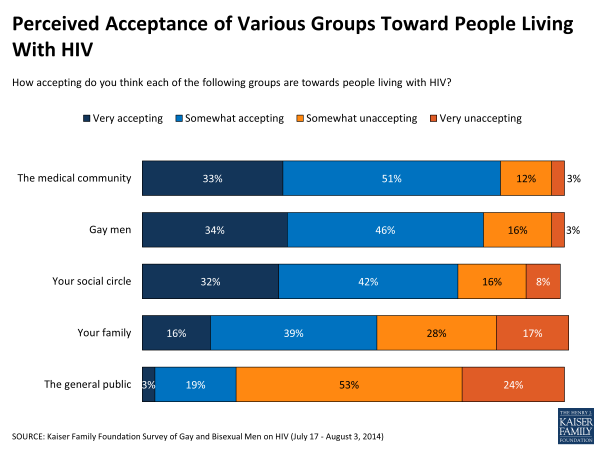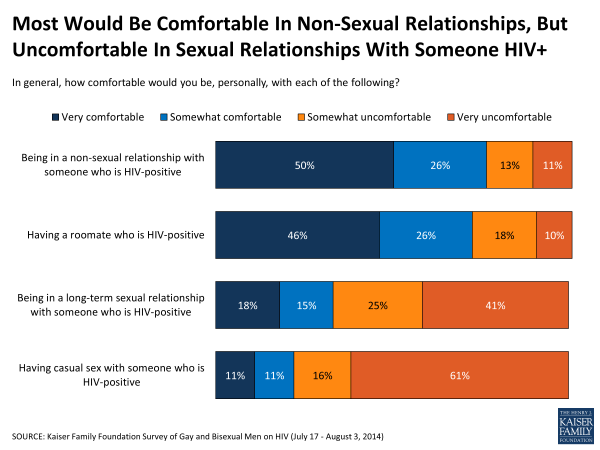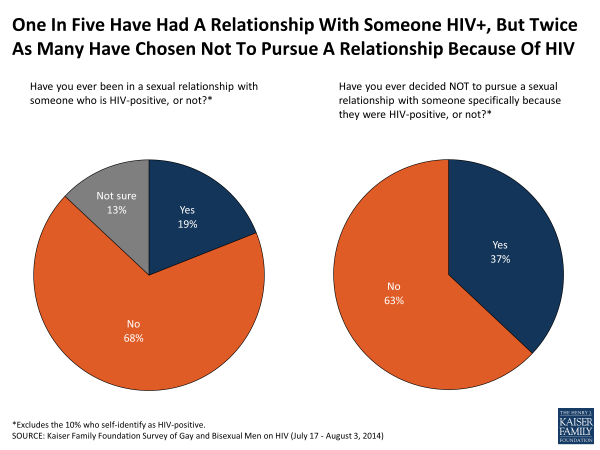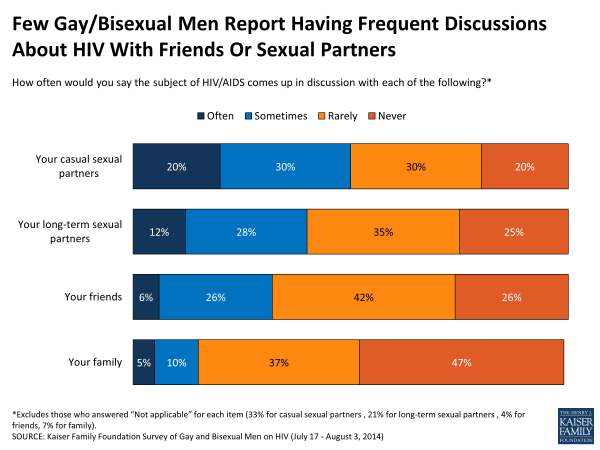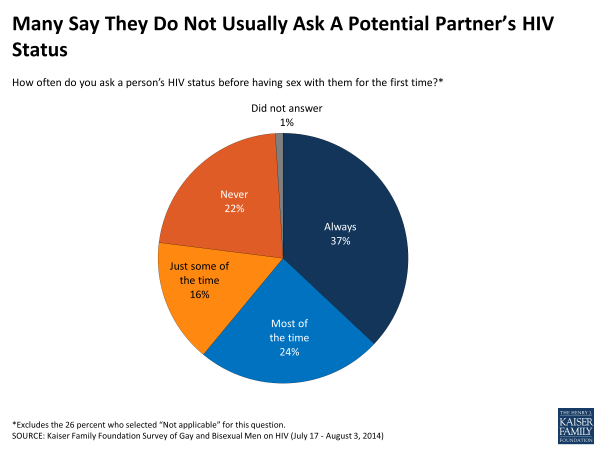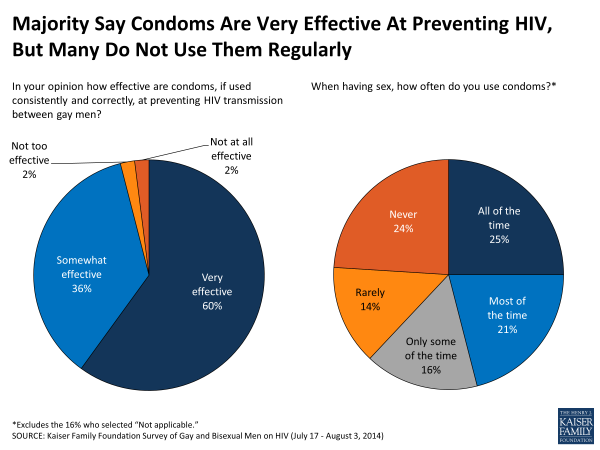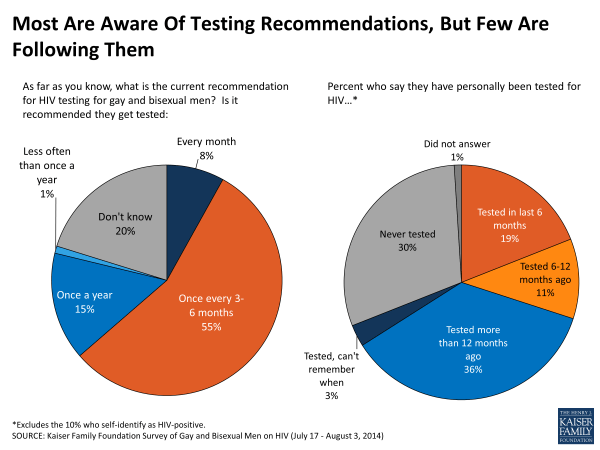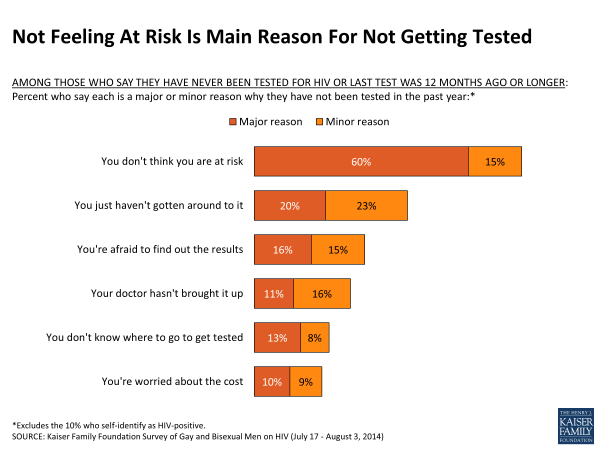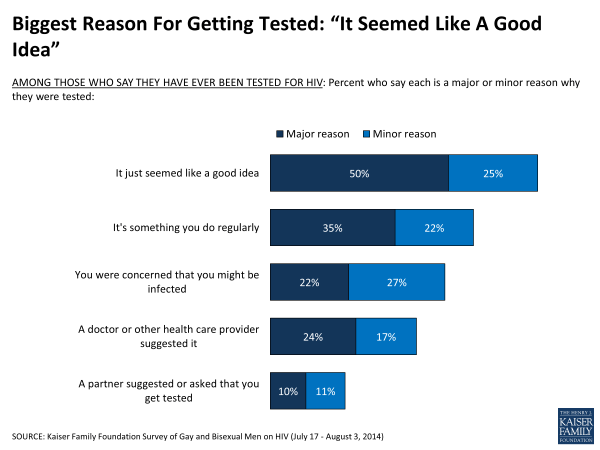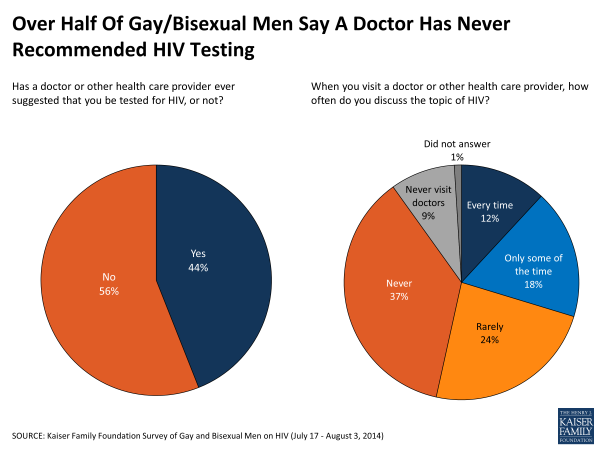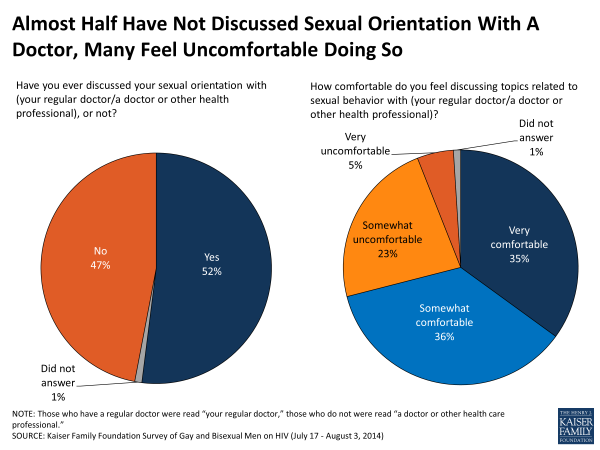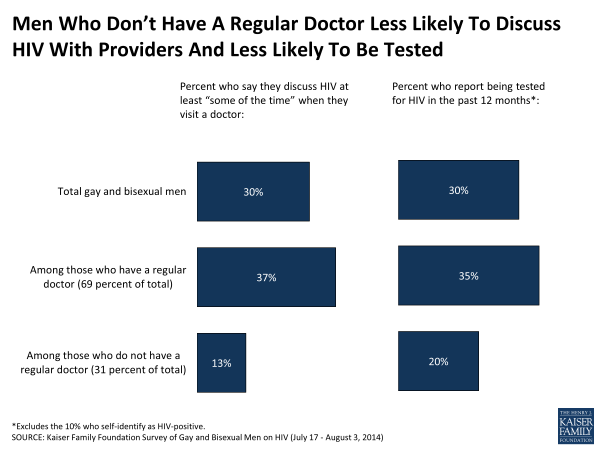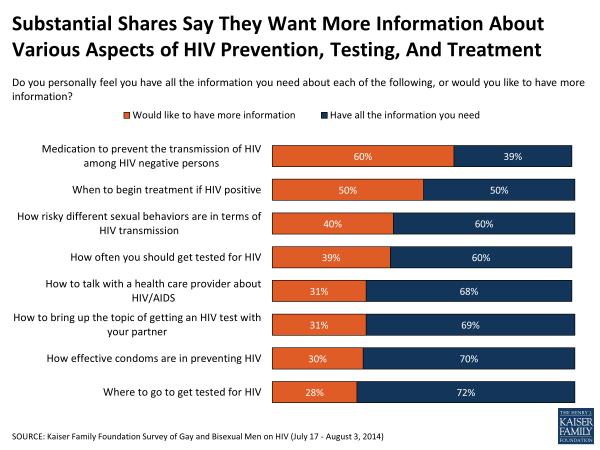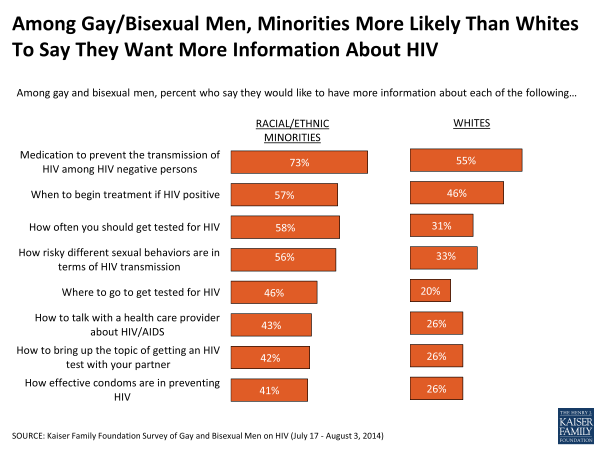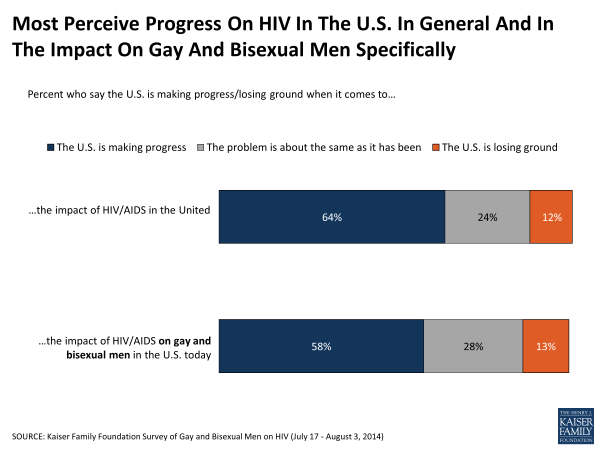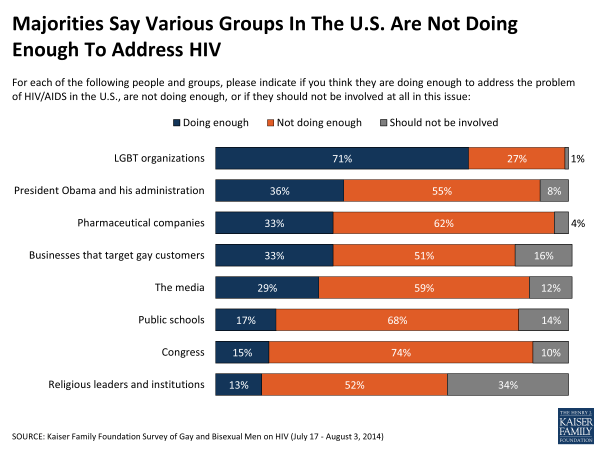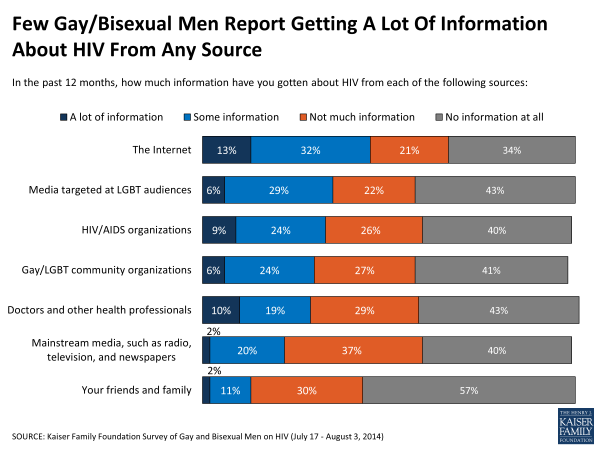HIV/AIDS In The Lives Of Gay And Bisexual Men In The United States
Liz Hamel, Jamie Firth, Tina Hoff, Jennifer Kates, Sarah Levine, and Lindsey Dawson
Published:
Executive Summary
From the earliest days of the HIV epidemic, gay and bisexual men have been among the hardest-hit groups in the United States. While gay men make up just 2 percent of the U.S. population, they account for two thirds (66 percent) of new HIV infections, a majority (56 percent) of people living with HIV, and more than half (55 percent) of all AIDS deaths since the epidemic’s beginning.1 It is estimated that 12-13 percent of gay and bisexual men in the U.S. are HIV-positive2, including one in five in many major U.S. cities3. Gay men are the only group in the country among whom new infections are on the rise; between 2008-2010, new infections rose 12 percent overall among gay men, and 22 percent among younger gay men ages 13-24.4 Recent research shows that antiretroviral therapy, which already has helped to dramatically increase the quality and length of life for people with HIV, has the potential to play a powerful role in the prevention of HIV. People living with HIV can reduce the risk of transmitting the infection to others by up to 96 percent if they are taking consistent ARV treatment5, and for those who are HIV negative, new pre-exposure prophylaxis (PrEP) offers a daily pill that can help them to stay negative.6
What do gay and bisexual men know and think about HIV, and about these new treatments? What are the obstacles to this population taking greater advantage of them? To help answer these questions, the Kaiser Family Foundation conducted a survey of gay and bisexual men in the U.S. focusing on attitudes, knowledge, and experiences with HIV/AIDS and new HIV therapies. The survey was conducted July 17-August 3, 2014 with a sample of 431 men who self-identified as either gay or bisexual using a nationally representative, probability-based Internet panel (more details available in the Survey Methodology section of this report). Some highlights of the survey are presented here, and a more comprehensive examination of the survey findings follows.
Highlights Of Survey Findings
- The survey allows us to provide some basic demographic information about gay and bisexual men, and finds that just over half (53 percent) report being in a committed relationship, including one in five (20 percent) who say they are married. Twelve percent live in a household with at least one child under the age of 18.
- About half of gay and bisexual men say HIV/AIDS is a “very” or “somewhat” significant issue for them personally (49 percent), while the other half say it is “not too significant” or “not a significant issue” in their lives (51 percent). However, just about a third (35 percent) say they are personally concerned about becoming infected, while more than half (56 percent) say they are not personally concerned.
- Just a third of gay and bisexual men realize that new infections are on the rise among gay men. About one in five (22 percent) think rates are decreasing and the rest either think the situation is staying the same or acknowledge that they don’t know.
- Most gay and bisexual men are not aware of current treatment recommendations for those who are HIV-positive, or of the latest developments in reducing new infections. Only about a quarter (26 percent) know about PrEP, a recently approved medication that people who are HIV-negative can take to lower their risk of becoming infected. Just one in ten know someone, including themselves, who has taken PrEP, and eight in ten say they have heard only a little or nothing at all about the new medication.
- Fewer than half (46 percent) of gay and bisexual men are aware that people with HIV should start antiretroviral (ARV) treatment as soon as they are diagnosed, and only a quarter (25 percent) know about treatment as prevention, or TasP; that is, that taking consistent ARV treatment significantly reduces the risk of passing HIV on to one’s sexual partners.
- Majorities say that too many gay men not knowing their status (75 percent), complacency about HIV in the gay community (62 percent), and HIV-related stigma (56 percent) are major reasons it’s been hard to control the spread of HIV among gay men.
- Few gay and bisexual men report talking much at all about HIV with friends or even with sexual partners. Three-quarters (68 percent) say they “rarely” or “never” discuss HIV with their friends, and large shares report not talking much about it with casual sexual partners (50 percent) or with long-term partners (60 percent).7
- Relatively few gay and bisexual men report getting tested for HIV as regularly as is often advised. While seven in ten say they have been tested at some point in their lives, just three in ten (30 percent) say they were tested in the last year, including 19 percent who say their most recent test was within the past 6 months. Fully three in ten (30 percent) say they have never been tested for HIV.8
- More than half (56 percent) of gay and bisexual men say that a doctor has never recommended they get tested for HIV, and six in ten (61 percent) say they rarely or never discuss HIV when they visit their doctor. Lack of communication with doctors may be a barrier to more men getting tested: almost half say they’ve never discussed their sexual orientation with a doctor, and three in ten say they don’t feel comfortable discussing sexual behaviors with health professionals. Three in ten gay and bisexual men report that they don’t have a regular physician, and these men (who tend to be younger, lower-income, and more racially diverse) are even less likely to report discussing HIV with doctors and to say they have been tested for HIV.
Highlights Of Differences Between Groups
The relatively modest sample size of the survey (431 men total) limits our ability to provide results among all subgroups of interest within the overall population of gay and bisexual men. However, we note some areas where responses differ significantly for some broad categories, including white men compared to members of racial and ethnic minority groups, and younger men (ages 18-34) compared with those ages 35 and older.
Differences by race/ethnicity
- Gay and bisexual men of color are more likely than those who identify as white to say HIV/AIDS is a significant issue for them personally (64 percent versus 42 percent) and that they are personally concerned about becoming infected (53 percent versus 28 percent).
- Nearly half (46 percent) of gay and bisexual men overall say they use condoms all or most of the time, although about a quarter (24 percent) say they never use condoms. Men of color are more likely than white men to report consistent condom use (61 percent versus 39 percent).9
- While most gay and bisexual men believe they have all the information they need about an array of issues related to the transmission and prevention of HIV, men of color are more likely than white men to say they want more information on most topics.
Differences by age
- There is a large generational divide in the share saying someone close to them has died from HIV/AIDS. Nearly half (47 percent) of gay and bisexual men ages 35 and older say they have lost someone close to them to the disease, while just 8 percent of those ages 18-34 say the same. Older men are also somewhat more likely than younger men to say they know someone currently living with HIV (54 percent versus 39 percent).
- Younger gay and bisexual men are twice as likely as older men to say they have never been tested for HIV (44 percent of those under age 35 versus 21 percent of those ages 35 and over). 10
- Men under the age of 35 are more likely than those ages 35 and older to say they would be uncomfortable having both sexual and non-sexual relationships with someone who is HIV-positive.
- Men ages 35 and older are more likely to support widespread use of PrEP (64 percent say it should be used widely and 35 percent think it should be used on a more limited basis), while those under age 35 lean in the other direction (56 percent say it should be used on a more limited basis and 43 percent think it should be used as widely as possible).
Key Findings
Section 1: Importance Of HIV/AIDS As An Issue, Personal Concern, And Personal Connections
HIV/AIDS As An Issue Facing Gay And Bisexual Men
Men in the United States who identify as gay or bisexual see HIV/AIDS as the number one health issue, and as a top priority among overall issues facing their community today. When asked in their own words to name the most important issue facing gay and bisexual men today, 20 percent name HIV/AIDS, ranking behind discrimination/lack of acceptance (43 percent) and roughly equal to two other issues: equal rights (26 percent) and marriage equality (24 percent). Asked specifically about health issues affecting gay and bisexual men, HIV is by far the number one issue at 52 percent, followed by other sexually transmitted diseases (28 percent). Smaller shares name safe sex in general (9 percent), mental health (8 percent), and drug use (8 percent).
While HIV is named as the top health care issue among all subgroups of gay and bisexual men, the share naming HIV is somewhat larger among those who identify as gay versus those who consider themselves bisexual (59 percent versus 35 percent), and among those who know someone who is currently living with HIV versus those who don’t (60 percent versus 41 percent).
Asked about a variety of policy issues affecting gay and bisexual men, just over half (54 percent) say efforts aimed at prevention and treatment of HIV should be a top priority, while nearly as many say the same thing about efforts to combat bullying and violence directed at LGBT youth (51 percent) and equal employment rights for LGBT people (47 percent). Slightly fewer see legal gay marriage (40 percent) and adoption rights for same-sex couples (29 percent) as top priorities, though it should be noted that large majorities see all of these priorities as at least “very important.”
In addition to seeing HIV as a priority for their community, about half of gay and bisexual men (49 percent) say HIV/AIDS is a “very” or “somewhat” significant issue for them personally, while the other half (51 percent) say it is “not too significant” or “not a significant issue” in their lives. Men who are members of racial and ethnic minority groups, as well as those who say they know someone living with HIV, are more likely than whites and those who don’t know someone living with the disease to say that HIV/AIDS is a significant personal issue.
Many are unaware that HIV infections are increasing among gay and bisexual men, the only risk group for which this is true in the United States.1 Just about a third (32 percent) know that the number of new infections each year among gay and bisexual men is increasing, while 22 percent think the number is decreasing, 26 percent say it’s staying about the same, and one in five say they don’t know. Men who identify as gay are somewhat more likely to know that new HIV infections are increasing compared with those who identify as bisexual (36 percent versus 22 percent).
Personal Concern about Risk
Only about a third (35 percent) of gay and bisexual men say they are at least somewhat concerned about becoming infected with HIV. Just over four in ten (43 percent) say they are concerned about contracting other STDs, while even more report being concerned about developing cancer (61 percent), having a heart attack (58 percent), and developing diabetes (44 percent).
Gay men of color are almost twice as likely their white counterparts to say they are at least somewhat concerned about becoming infected with HIV (53 percent versus 28 percent).2 Similarly among the general population, Black Americans are more likely than whites to say they’re personally concerned about becoming infected (36 percent versus 14 percent).3
Personal Connections
About half (49 percent) of gay and bisexual men overall say they know someone who is currently living with HIV, and 32 percent say someone close to them has died from HIV/AIDS. Among the general public, these shares are much smaller – just one in five (19 percent) say they know someone living with HIV and 15 percent have lost someone close to them to the disease. Among African Americans nationally – another group besides gay and bisexual men that is disproportionately affected by HIV – just over a quarter (27 percent) say they know someone living with the disease, and a similar share (28 percent, almost equal to the rate among gay men) say someone close to them has died from it.
Among gay and bisexual men, there is a large generational divide in the share saying someone close to them has died from HIV/AIDS. Nearly half (47 percent) of those ages 35 and older say they have lost someone close to them to the disease, while just 8 percent of those ages 18-34 say the same. Older men are also somewhat more likely than younger men to say they know someone currently living with HIV (54 percent versus 39 percent).
Ten percent of gay and bisexual men indicated that they themselves are HIV-positive. However, this is likely to be an underestimate of the true rate in the population, since some men may have chosen not to disclose their own status in the survey, and others are likely to be unaware they are HIV-positive. It is estimated that approximately 12 to 13 percent of all gay and bisexual men in the United States are HIV-positive4, including one in five in many major U.S. cities5. The U.S. Centers for Disease Control and Prevention (CDC) also estimates that 18 percent of gay and bisexual men with HIV do not know their status.6
Section 2: Awareness And Opinions About HIV Prevention And Treatment
Gaps In Awareness About HIV Prevention And Treatment: PrEP, TasP, and When to Start
Most gay and bisexual men are not aware of current treatment recommendations for those who are HIV-positive, or of the latest developments in reducing new infections. Only about a quarter (26 percent) know about PrEP (pre-exposure prophylaxis), a recently approved prescription medication that people who are HIV-negative can take to lower their risk of becoming infected (this is somewhat higher than the general public, 14 percent). Three in ten (31 percent) believe no such medication exists, and over four in ten (43 percent) say they don’t know.
Gaps in awareness also exist when it comes to antiretroviral (ARV) treatment recommendations for those who are HIV-positive. Fewer than half (46 percent) of gay and bisexual men know that someone living with HIV should begin ARV treatment as soon as they are diagnosed, while 17 percent believe they should wait until their CD4 count falls below a certain level, and over a third (35 percent) say they don’t know the recommendation.1
While most gay and bisexual men know that antiretroviral medications (ARVs) are effective at helping people with HIV live longer (82 percent) and improving the health of people with HIV (77 percent), far fewer realize that they’re also effective in preventing the spread of HIV to sexual partners (36 percent) (otherwise known as “treatment as prevention” or TasP).2
Further, only a quarter (25 percent) of gay and bisexual men know that if someone with HIV is taking consistent ARV treatment, it significantly reduces the risk of passing on HIV to their sexual partners (about the same as the general public, 21 percent). A plurality (39 percent) believe that consistent ARV treatment does not reduce the risk of transmission, and over a third (36 percent) say they don’t know enough to answer.
Men who identify as gay are more likely than those who consider themselves bisexual to be aware that taking consistent ARV reduces the risk of transmission (29 percent versus 15 percent), and that there is a prescription medicine HIV-negative people can take to lower their risk (32 percent versus 15 percent).
More About Pre-Exposure Prophylaxis (PrEP)
As noted above, just a quarter of gay and bisexual men know that a medication exists to reduce a person’s risk of contracting HIV. In a more specific question that mentions both the term pre-exposure prophylaxis (PrEP) and the brand name Truvada, just one in five say they have heard “a lot” (9 percent) or “a fair amount” (11 percent) about this new medication. One-quarter say they have heard “only a little” about PrEP, while over half (55 percent) say they’ve heard “nothing at all.” Just one in ten say they personally know someone who has taken PrEP for HIV prevention, including 5 percent who say they have taken the medication themselves.
When told of the existence of PrEP, just over half (56 percent) of gay and bisexual men say they agree with the view that the new medication “should be used as widely as possible among gay men because every available prevention tool should be used to limit the spread of HIV in communities at risk,” while about four in ten (43 percent) think it “should be used on a more limited basis among gay men because people using it may be less likely to use condoms consistently, putting them at risk for other sexually transmitted diseases.”
Gay and bisexual men ages 35 and older are more likely to support widespread use of PrEP (64 percent say it should be used widely and 35 percent think it should be used on a more limited basis), while those under age 35 lean in the other direction (56 percent say it should be used on a more limited basis and 43 percent think it should be used as widely as possible).
Section 3: Perceived Barriers, Stigma, And Talking About HIV
Perceived Barriers To Reducing HIV
When asked about reasons why it has been difficult to reduce the spread of HIV in the gay community, gay and bisexual men see a number of factors as “major” reasons, including too many gay men not knowing their HIV status (75 percent), complacency about HIV in the gay community (62 percent), and HIV-related stigma (56 percent). Just three in ten (31 percent) see lack of understanding about how to prevent transmission as a major barrier to curbing the spread of the disease, although the survey results indicate there are significant knowledge gaps about newer prevention options available to reduce the risk of contracting HIV, namely PrEP and treatment as prevention. Few (17 percent) say that lack of focus on HIV by LGBT organizations is a major reason why it has been difficult to slow the spread of HIV among gay men.
Men of color are more likely than those who identify as white to say lack of understanding about HIV prevention is a major reason (48 versus 23 percent).
Stigma, Violence, And Discrimination
Discrimination and stigma (whether HIV-related or not) is the most frequently-named issue when asked about the most important issues facing gay and bisexual men today. When it comes to their own experiences, many report having faced various forms of stigma and discrimination as a result of their sexual orientation, including being rejected by a friend or family member (32 percent), being threatened or physically attacked (26 percent), experiencing unfair treatment from an employer (15 percent), poor treatment from a medical professional (15 percent), and discrimination in trying to find housing (7 percent).
On the topic of HIV-related stigma, about a third of gay and bisexual men say that gay men as a group and their own social circles are “very” accepting towards people with HIV, and an additional four in ten say each of these groups is “somewhat” accepting. The medical community ranks similarly high in perceived acceptance (33 percent say they are “very” accepting and 51 percent say they are “somewhat” accepting). Their own families are perceived as somewhat less accepting of HIV-positive persons (16 percent “very” and 39 percent “somewhat”). However, the large majority (77 percent) of gay and bisexual men believe the general public is unaccepting of people living with HIV.
When asked why they think some people with HIV might be reluctant to tell others about their status, gay and bisexual men see a variety of factors as major reasons, including fear of rejection by family and friends (79 percent), fear of rejection by intimate partners (76 percent), fear of discrimination in housing, jobs, or other situations (76 percent), and a general desire for privacy (62 percent).
Large majorities of gay and bisexual men say they would be uncomfortable having a sexual relationship with a person who is HIV-positive, including being in a long-term sexual relationship (66 percent) and having casual sex (77 percent). By comparison, three-quarters say they would be “very” or “somewhat” comfortable being in a non-sexual relationship with someone who is HIV-positive (76 percent) and a similar share say the same about having an HIV-positive roommate (72 percent, a rate that is much higher than the general public at 46 percent).
Gay and bisexual men under the age of 35 are more likely than those ages 35 and older to say they would be uncomfortable having both sexual and non-sexual relationships with someone who is HIV-positive, as are those who identify as bisexual compared with those who identify as gay.
| REPORTED COMFORT IN SEXUAL AND NON-SEXUAL RELATIONSHIPS WITH SOMEONE WITH HIV | ||||
| Ages 18-34 | Ages 35+ | Bisexual | Gay | |
| In general, how comfortable would you be… | ||||
| …being in a non-sexual relationship with someone who is HIV-positive | ||||
| Very or somewhat comfortable | 60% | 84% | 60% | 82% |
| Very or somewhat uncomfortable | 40 | 15 | 40 | 17 |
| …being in a long-term sexual relationship with someone who is HIV-positive | ||||
| Very or somewhat comfortable | 22 | 41 | 14 | 41 |
| Very or somewhat uncomfortable | 79 | 60 | 86 | 58 |
| …having casual sex with someone who is HIV-positive | ||||
| Very or somewhat comfortable | 11 | 28 | 12 | 26 |
| Very or somewhat uncomfortable | 89 | 71 | 88 | 74 |
Some men do report having been in “serodiscordant” relationships – that is, where their partner’s HIV status is different from theirs. One in five (19 percent) of those who didn’t identify themselves as HIV-positive say they’ve been in a sexual relationship at some point with someone who has HIV, and another 13 percent say they’re “not sure” if they’ve ever been in such a relationship. Still, an even larger share of this group (37 percent) say that at some point they have decided not to pursue a sexual relationship with someone specifically because they were HIV-positive.
Another issue of importance is that of sexual violence, including intimate partner violence. Eighteen percent of gay and bisexual men say that at some time in their life, a person has attempted to force them to have sex or engage in a sex act against their will, including 4 percent who say this happened in the past year.
Conversations About HIV
Few gay and bisexual men report talking much at all about HIV with friends or even with sexual partners. Large majorities say the topic of HIV comes up “rarely” or “never” in conversations with their friends (68 percent) or family members (84 percent). Compared with the general public, gay and bisexual men are somewhat more likely to say they discuss HIV with their friends at least “sometimes” (32 percent versus 22 percent), though they are no more likely than the general public to report discussing it with family members (15 percent versus 19 percent).
While gay and bisexual men are more likely to report discussing HIV with their sexual partners than with family and friends, still a majority (60 percent) say they “rarely” or “never” discuss the topic with their long-term partners, and half (50 percent) say the same about their casual partners. While these conversations may not be occurring with frequency, gay and bisexual men are more likely than the general public to report talking with sexual partners about HIV. Among adults in general, more than eight in ten (82 percent), say the subject of HIV/AIDS “rarely” or “never” comes up in discussions with their spouse or other intimate partners. 1
When it comes to conversations about HIV with long-term sexual partners, gay and bisexual men of color are more likely than whites to say they discuss the topic at least “sometimes” (52 percent versus 34 percent), and those who identify as gay are more likely to report these conversations than those who consider themselves bisexual (47 percent versus 27 percent).
Asked more specifically about discussions at the beginning of new relationships, most gay and bisexual men (61 percent) say they ask a person’s HIV status before beginning a sexual relationship “always” or “most of the time,” although nearly four in ten say they don’t routinely ask, including 22 percent who say they “never” do so.2
Section 4: Condom Use And HIV Testing
Attitudes And Reported Behaviors About Condoms
According to the CDC, when used consistently and correctly, condoms are highly effective at preventing the spread of HIV and many other sexually transmitted diseases.1 Six in ten gay and bisexual men (60 percent) consider condoms to be “very” effective at preventing HIV transmission between gay men, and most of the remainder (36 percent) say they are “somewhat” effective. Still, fewer than half (46 percent) say they use condoms “all of the time” or “most of the time” when having sex, and nearly a quarter (24 percent) say they never use condoms.2
Notably, gay and bisexual men who are members of racial and ethnic minority groups are more likely than their white counterparts to say they use condoms all or most of the time (61 percent versus 39 percent).
Attitudes And Reported Behaviors About HIV Testing
The CDC recommends that gay and bisexual men be tested for HIV at least annually and that those who are sexually active may benefit from more frequent testing (every 3 to 6 months)3, a recommendation already made by many health departments, particularly in areas where gay and bisexual men have been hard hit by HIV. Nearly two-thirds of gay and bisexual men say that testing is recommended more than once annually, including 55 percent who say it should be every 3-6 months and 8 percent who say it should be every month. Men who identify as gay are more likely than those who identify as bisexual to think testing should be at least every 3-6 months (70 percent versus 50 percent).
Relatively few gay and bisexual men report getting tested as regularly as is often advised. While seven in ten say they have gotten an HIV test at some point in their lives, just one in five (19 percent) say they were tested within the past 6 months. Another one in nine (11 percent) report having been tested between 6 and 12 months ago, while 36 percent say their last test was over a year ago and 3 percent can’t remember when they were last tested. Fully three in ten (30 percent) say they have never been tested for HIV, a share that rises to 44 percent among those under age 35.4
Gay and bisexual men who identify as white are more likely than men of color to say they have ever been tested for HIV (74 percent versus 59 percent), though the share that reports being tested within the past 6 months is similar for both groups (18 percent among white men, 23 percent among men of color).
Among those who have never been tested or who have let more than a year elapse since their last test, by far the most common reason is not feeling at risk (60 percent say this is a major reason). Fewer say they just haven’t gotten around to it (20 percent), they were afraid to find out the results (16 percent), they didn’t know where to go to get tested (13 percent), their doctor never brought it up (11 percent), or they were worried about the cost (10 percent).
Among gay and bisexual men who have been tested for HIV, the most common reason they say they decided to do so was “it just seemed like a good idea” (50 percent say this is a major reason), followed by “it’s something you do regularly” (35 percent), having a test suggested by a doctor (24 percent), being concerned about being infected (22 percent), and a suggestion or request from partner that they get tested (10 percent).
Among those who have been tested, six in ten (60 percent) say their most recent test was conducted as part of another health visit such as a regular check-up, while a third (33 percent) say they went to a doctor or clinic specifically to get an HIV test.
Lack Of Communication With Doctors As A Barrier To Testing And Care
Doctors play an important role in getting people tested for HIV and getting them into treatment, yet more than half of gay and bisexual men (56 percent) say that no doctor or health care provider has ever suggested they get tested. While three in ten (30 percent) say they discuss the topic of HIV at least “some of the time” when they visit a doctor, six in ten (61 percent) say they “rarely” or “never” discuss the topic with any health care provider.
Lack of open communication with doctors may be a barrier to more gay and bisexual men getting the health care they need, including HIV testing. Almost half (47 percent) say they’ve never discussed their sexual orientation with a doctor or other health care professional. While most (71 percent) say they feel “very” or “somewhat” comfortable discussing topics related to sexual behavior with their doctor, almost three in ten (28 percent) say they feel uncomfortable doing so. As noted above, 15 percent say that they’ve received poor treatment from a health care professional at some point because of their sexual orientation.
Bisexual men are even less likely to report openly communicating with their doctors about HIV and sexual behavior: 67 percent say they’ve never discussed their sexual orientation with a health professional, 45 percent say they feel uncomfortable discussing sexual behavior with their doctor, 77 percent say they rarely or never talk about HIV with doctors, and 72 percent say no health care provider has ever suggested they be tested for HIV.
Lack of access to health care providers may also be a barrier to more frequent HIV testing and health care for some gay and bisexual men. Three in ten (31 percent) either say they don’t have a regular place to go for medical care or that they don’t have a regular physician, and these men (who tend to be younger, lower-income, and more racially diverse) are less likely to report discussing HIV with doctors, and less likely to report getting tested.
Section 5: Information And The Role Of Different Groups
Interest In Getting More Information About HIV
While many gay and bisexual men say they “have all the information they need” about various aspects of HIV prevention, testing, and treatment, substantial shares say they would like to know more. At the top of the list, six in ten (60 percent) would like to have more information about medication to prevent the transmission of HIV among HIV-negative persons, and half (50 percent) say they’d like to know more about how soon to begin treatment after testing positive. About four in ten say they’d like more information about the relative risk of different sexual behaviors (40 percent) and how often to get tested (39 percent), while about three in ten want to know more about how to bring up the topic of testing with a partner (31 percent), how to talk with health care providers about HIV (31 percent), the effectiveness of condoms (30 percent), and where to go to get tested (28 percent).
Gay and bisexual men who are members of racial and ethnic minority groups are more likely than their white counterparts to say they’d like to have more information in most of these areas. For example, 58 percent of minorities versus 31 percent of whites say they want more information about how often to get tested, and 46 percent of minorities versus 20 percent of whites want to know more about where to go to get an HIV test. These results are consistent with earlier Kaiser Family Foundation surveys of the general public, which found that African Americans and Hispanics were more likely than whites to report a desire for more HIV-related information.1
Perceptions Of Progress And Who Is Doing Enough To Combat HIV
Nearly two-thirds (64 percent) of gay and bisexual men say the U.S. is making progress when it comes to the impact of HIV in the country today, higher than the share of the general public who say the same (40 percent). A majority (58 percent) of gay and bisexual men also believe the U.S. is making progress in regards to the impact of HIV on gay and bisexual men specifically, while 28 percent feel the problem is about the same as it has been and 13 percent say the U.S. is losing ground.
There is a general consensus among gay and bisexual men that various groups are not doing enough to address the problem of HIV in the U.S., including Congress (74 percent say they’re not doing enough), public schools (68 percent), pharmaceutical companies (62 percent), the media (59 percent), President Obama and his administration (55 percent), religious leaders and institutions (52 percent) and businesses that target gay consumers (51 percent).
In contrast to these other institutions, 71 percent of gay and bisexual men feel that LGBT organizations are doing enough to address the problem of HIV. And as noted above, relatively few (17 percent) say lack of focus on HIV by LGBT organizations is a major reason why it has been difficult to slow the spread of HIV among gay men. Still, some would like to see more focus on HIV by gay community leaders. While a majority (56 percent) of gay and bisexual men say gay leaders are paying the right amount of attention to the issue of HIV relative to other issues, about a third (34 percent) say they’re paying too little attention.
Despite a general sense that LGBT organizations are doing enough to address the problem of HIV/AIDS in the U.S., few gay and bisexual men say that they’ve personally gotten a lot of information about the disease from these organizations – or from any other source – in the past year.
The most commonly reported source of information on HIV/AIDS is the Internet (45 percent say they have gotten at least “some” information from this source in the past year), followed by LGBT media (35 percent), HIV/AIDS organizations (33 percent), LGBT community organizations (30 percent), doctors and other health professionals (29 percent), mainstream media (22 percent), and friends and family (13 percent).
Section 6: Some Key Characteristics Of Gay And Bisexual Men
In addition to their opinions and experiences related to HIV/AIDS, this survey allows us to provide some basic demographic information about gay and bisexual men. Overall, seven in ten (70 percent) call themselves gay and three in ten (30 percent) think of themselves as bisexual. One in five (20 percent) say they are married, including a much higher percentage of bisexual men (42 percent) compared with gay men (10 percent). Including those who are married, in a civil union, or living with a partner, about half (53 percent) say they are in a committed relationship (including similar shares of those who identify as gay and those who identify as bisexual). Twelve percent live in a household with at least one child under the age of 18. Just 13 percent say they live in an area known for being an LGBT neighborhood, while the vast majority (86 percent) say they do not.
When it comes to health care, the large majority (82 percent) say they are covered by some form of health insurance, most commonly from an employer or labor union (52 percent), followed by Medicare (16 percent), Medicaid (11 percent), plans purchased on their own outside the new health insurance marketplace (6 percent), and plans purchased from the new marketplace (4 percent). Thirteen percent say they do not have any form of health insurance.
Nearly eight in ten (78 percent) say they have a regular place to go for health care, most commonly a doctor’s office or HMO (54 percent) or a general clinic or health center (14 percent). However, as noted above, three in ten either have no usual source of care (22 percent) or do not have a regular personal doctor at the place they usually seek care (9 percent).
When it comes to politics, over three-quarters (77 percent) of gay and bisexual men say they are registered to vote at their present address, and the vast majority identify as a Democrat (56 percent) or a Democratic-leaning independent (23 percent). Just 9 percent call themselves Republicans and 8 percent are independents who lean toward the Republican Party. Ideologically, two-thirds (67 percent) call themselves liberal, while 20 percent say they are moderate and 12 percent say they are conservative. Over four in ten (42 percent) report no religious affiliation. The most commonly reported religious affiliations are Catholic (17 percent), Protestant – including Methodist, Lutheran, Presbyterian and Episcopal (15 percent), Baptist (8 percent), and other Christian denominations (7 percent).
Methodology
Survey Methodology
The Kaiser Family Foundation Survey of Gay and Bisexual Men on HIV was designed and analyzed by researchers at the Kaiser Family Foundation (KFF), and was conducted July 17-August 3, 2014, among a nationally representative sample of 431 men ages 18 and older who self-identified as gay or bisexual. The survey was funded by M·A·C AIDS Fund. Interviews were conducted in English and Spanish using GfK’s KnowledgePanel, an online research panel. KnowledgePanel members are recruited through probability sampling methods and include both those with internet access and those without (KnowledgePanel provides internet access for those who do not have it and, if needed, a device to access the internet when they join the panel). A combination of random digit dialing (RDD) and address-based sampling (ABS) methodologies have been used to recruit panel members (in 2009 KnowledgePanel switched its sampling methodology for recruiting panel members from RDD to ABS). The panel comprises households with landlines and cellular phones, including those with only cell phones, and those without a phone. Both the RDD and ABS samples were provided by Marketing Systems Group (MSG). KnowledgePanel continually recruits new panel members throughout the year to offset panel attrition as people leave the panel.
Panel members complete an annual profile survey that includes a range of demographic, attitudinal and behavioral questions, including questions about sexual orientation. Men who identified as gay or bisexual on the profile survey were eligible for the KFF survey sample and were sent an invitation to complete the survey. Respondents were asked to reconfirm their sexual orientation using the following question: Do you consider yourself to be 1) Heterosexual or straight, 2) Gay, 3) Bisexual, 4) Other? Men who had previously identified as gay or bisexual but selected something other than one of these options in the screening interview were asked: In an earlier survey, you identified as gay/bisexual. Do you still consider yourself to be gay/bisexual, or not? The vast majority of respondents in the final sample (97 percent) re-confirmed their identity as gay or bisexual on the first question, and 3 percent reconfirmed on the second question. Respondents who did not reconfirm as gay or bisexual on either question were thanked for their time and told that the interview was over.
The survey data were weighted to be representative of gay and bisexual men nationwide. Weighting took place in several stages. First, all members of the panel carry a weight designed to produce a nationally representative sample of the U.S. adult population. This weight matches gender, age, race/ethnicity, education, region, household income, homeownership status, metropolitan area, and Internet access to parameters from the March 2013 Supplement of the Census Bureau’s Current Population Survey (CPS).1
In the second stage, the sample of gay and bisexual men was weighted to match known national parameters where available, and to match the full sample of panel members who identify as gay and bisexual men on characteristics for which no national parameters are available. The sample was weighted using an iterative technique to match age, race/ethnicity, region, and education to parameters for gay and bisexual men from the 2013 National Health Interview Survey (NHIS), and to match primary language, Internet access, metropolitan area, and household income to targets derived from the weighted sample of all gay and bisexual men in the panel.
Margins of sampling error and tests of statistical significance take into account the effect of weighting at each of these stages. The margin of sampling error including the design effect for the full sample of 431 gay and bisexual men is plus or minus 7 percentage points. Numbers of respondents and margin of sampling error for key subgroups are shown in the table below. For results based on other subgroups, the margin of sampling error may be higher. Sample sizes and margin of sampling errors for other subgroups are available by request. Note that sampling error is only one of many potential sources of error in this or any other public opinion poll.
| Group | N (unweighted) | M.O.S.E. |
| Total gay and bisexual men | 431 | ±7 percentage points |
| Gay | 299 | ±8 percentage points |
| Bisexual | 132 | ±12 percentage points |
| Racial/ethnic minorities | 142 | ±12 percentage points |
| Whites | 289 | ±8 percentage points |
| Ages 18-34 | 101 | ±12 percentage points |
| Ages 35 and over | 330 | ±8 percentage points |
Some of the same questions that were asked on the Survey of Gay and Bisexual Men on HIV were also asked of the general public as part of the July 2014 Kaiser Health Tracking Poll, a nationally representative telephone survey. More detail on that survey’s methodology, along with the full question wording and results, are available at https://www.kff.org/wp-content/uploads/2014/08/8618-t.pdf.
Endnotes
Executive Summary
KFF analysis of CDC data.
KFF analysis of CDC data.
CDC, HIV Testing Among Men Who Have Sex with Men --- 21 Cities, United States, 2008, MMWR, Volume 60(21), June 2011.
CDC, Estimated HIV Incidence in the United States, 2007-2010. http://www.cdc.gov/hiv/pdf/statistics_hssr_vol_17_no_4.pdf
National Institutes of Health, Treating HIV-infected People with Antiretrovirals Protects Partners from Infection, May 12, 2011. http://www.niaid.nih.gov/news/newsreleases/2011/pages/hptn052.aspx
U.S. Food and Drug Administration news release, July 16, 2012. http://www.fda.gov/newsevents/newsroom/pressannouncements/ucm312210.htm
This analysis excludes those who selected “not applicable” for each item (4 percent for friends, 33 percent for casual sexual partners, 21 percent for long-term sexual partners).
This analysis excludes the 10 percent who self-identify as HIV-positive.
This analysis excludes the 16 percent who selected “not applicable” for the question about condom use.
This analysis excludes the 10 percent who self-identify as HIV-positive.
Key Findings
Section 1: Importance Of HIV/AIDS As An Issue, Personal Concern, And Personal Connections
CDC, Estimated HIV Incidence in the United States, 2007-2010. http://www.cdc.gov/hiv/pdf/statistics_hssr_vol_17_no_4.pdf
Note that the sample size of the survey of gay and bisexual men does not allow us to break out the responses for African Americans specifically.
Throughout this report, comparison data for the general public and Black Americans (another group at high risk for HIV infection) come from KFF’s July Health Tracking Poll, a monthly nationally-representative telephone survey. Full results of that survey are available at https://www.kff.org/wp-content/uploads/2014/08/8618-t.pdf
KFF analysis of CDC data.
CDC, HIV Testing Among Men Who Have Sex with Men --- 21 Cities, United States, 2008, MMWR, Volume 60(21), June 2011.
CDC, Monitoring Selected National HIV Prevention and Care Objectives by Using HIV Surveillance Data—United States and 6 Dependent Areas—2011, HIV Surveillance Supplemental Report, Volume 18(5), October 2013. http://www.cdc.gov/hiv/pdf/2011_Monitoring_HIV_Indicators_HSSR_FINAL.pdf
Section 2: Awareness And Opinions About HIV Prevention And Treatment
Department of Health and Human Services, Guidelines for the Use of Antiretroviral Agents in HIV-1-Infected Adults and Adolescents/Initiating Antiretroviral Therapy in Treatment-Naive Patients, May 1, 2014. http://aidsinfo.nih.gov/guidelines/html/1/adult-and-adolescent-arv-guidelines/10/initiating-art-in-treatment-na%C3%AFve-patients
National Institutes of Health, Treating HIV-infected People with Antiretrovirals Protects Partners from Infection, May 12, 2011 http://www.niaid.nih.gov/news/newsreleases/2011/pages/hptn052.aspx
Section 3: Perceived Barriers, Stigma, And Talking About HIV
This analysis excludes those who selected “not applicable” for each item (4 percent for friends, 7 percent for family, 21 percent for long-term sexual partners, 33 percent for casual sexual partners).
This analysis excludes the 26 percent who selected “not applicable” for this question.
Section 4: Condom Use And HIV Testing
CDC, Condoms and STDs: Fact Sheet for Public Health Personnel. http://www.cdc.gov/condomeffectiveness/latex.htm
This analysis excludes the 16 percent who selected “Not applicable” for this question.
CDC, HIV Among Gay and Bisexual Men. http://www.cdc.gov/hiv/risk/gender/msm/facts/index.html
This analysis excludes the 10 percent who self-identify as HIV-positive.
Section 5: Information And The Role Of Different Groups
Kaiser Family Foundation, HIV/AIDS at 30: A Public Opinion Perspective, June 1, 2011. https://www.kff.org/hivaids/report/hivaids-at-30-a-public-opinion-perspective/
Methodology
Survey Methodology
Details about KnowledgePanel sampling, recruitment, and weighting methodology, including details about how design weights are calculated, is available at http://www.knowledgenetworks.com/knpanel/docs/knowledgepanel(R)-design-summary-description.pdf

